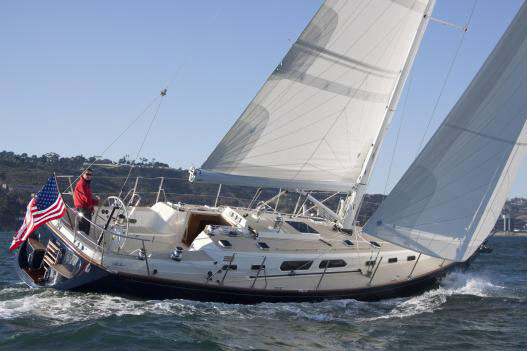Perry Design Review: Sabre 402
A cruiser-racer with accommodations to outdo the competition
August 25, 2000
Boats longer than 40 feet start to get near the limit of what a husband-and-wife team can comfortably handle in tight areas. Forty feet is also important because the designer can put in two separated, dedicated sleeping areas. You need to be up around 50 feet before you can design three sleeping areas. So the pressure on the designer of the 40-footer is to utilize all the available living volume without foregoing the lazarette, forepeak, or accumulating copious displacement.
The Sabre 402 is a good-looking modern boat. I like the low house contours and the short ends combined with moderate freeboard. Jim Taylor has a good eye. At 13 feet, 3 inches wide, it's a bit of a fatso, but that is what it takes to outdo the competition when it comes to accommodations.
You can choose from a wing keel drawing 4 feet, 9 inches or a deeper fin with a bulbish tip at 6 feet, 3 inches. I'd like to see a deeper rudder, but I would guess the rudder shown was drawn to accommodate both keels. Note the marked leading- and trailing-edge fillets on the keel. Jim can draw fast boats, and with good sails and a fair PHRF rating, this boat could be a comfortable racer.
The first thing I notice about the interior is that the designers have sacrificed both forepeak and lazarette, although there is a large cockpit storage locker adjacent to the port side double berth. Doing away with large stowage areas in the ends lets the accommodations expand.
Now look at the angled bulkheads. I have no doubt that some interior designers use angled bulkheads because they think they look cool, but give little thought to exactly how the volume trade-off is balanced. Indiscreet use of too many different angles can give the effect that the interior is an exercise in optical illusions as your eyes strain to somehow make geometric harmony. Not so in this boat. The angled bulkheads are cleverly arranged to capture the volumes needed to enhance each area.
The forward cabin is big and includes a long bench seat, sink, vanity and two roomy hanging lockers. The foot of the double berth is too pinched for my size 14s, but probably adequate. The saloon, with its angled table, will work well, and six should be able to sit and dine at the table. Note how mast placement leaves room for access around either end of the table. The navigation area is well laid-out, as is the big galley. Note the abundant counter space surrounding the sinks. I'm glad to see only one head, with an adjoining shower stall, on this design. Two heads seem too great a convenience on a 40-footer relative to the volume lost. The aft stateroom, with its angled double, looks to be as comfortable as the forward stateroom.
The rig is a double-spreader masthead sloop with enough room in the foretriangle for someone to carry a Solent stay and small staysail if they insisted. Shrouds are in-line. Construction features a balsa-cored hull with Isopthalic gelcoat above the waterline backed up with vinylester resin.
This is a well-proportioned boat that will help elevate the standards for dual-purpose family boats.
Good sails and a fair rating could make this a dual-purpose cruiser.
Boat Specifications
| LOA | 40'2" |
| LWL | 34' |
| Beam | 13'3" |
| Draft | wing keel 4'9", deep 6'3" |
| Displacement | 18,500 lbs. |
| Ballast | 7,500 lbs. |
| Sail Area | 822 sq. ft. |
| SA/D ratio | 18.8 |
| D/L ratio | 210 |
| L/B | 303 |
| Auxiliary | 4-cylinder 50-horsepower |
| Fuel | 50 gals. |
| Water | 110 gals. |
 This story originally appeared in Sailing Magazine, and is republished here by permission. Subscribe to Sailing.
This story originally appeared in Sailing Magazine, and is republished here by permission. Subscribe to Sailing.

















